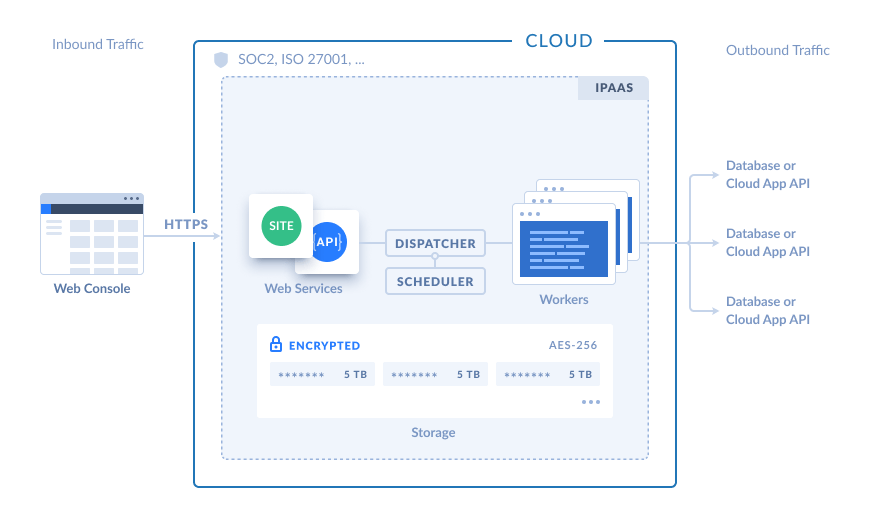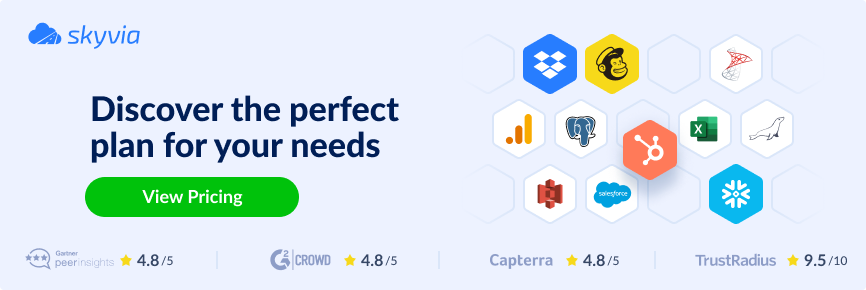As we wrote before, data integration between different sources is a crucial task that most of the businesses need to solve. Since the task is so widespread, there is a large number of tools for solving it — from coding libraries to ready-to-use tools — on-premises and cloud based. This article describes the latter — cloud or iPaaS systems.
Read this article if you want to know what is iPaaS, and top iPaaS vendors. It describes, how iPaaS systems work and what are the benefits of using iPaaS.
Table of contents
- iPaaS Meaning and Definition
- iPaaS vs PaaS vs SaaS
- How Does iPaaS Work?
- iPaaS Features
- Benefits of Using iPaaS
- Examples and Use Cases
- IPaaS Vendors and Providers
- Skyvia: Best IPaaS for Cloud Integration
iPaaS Meaning and Definition
What is iPaaS? First, iPaaS is an acronym. iPaaS stands for Integration Platform as a Service. We can define iPaaS as a platform that automates integration tasks loads data between different data sources or automates workflows requiring actions in one applications to be triggered by events from other applications.
By the *aaS definition, such systems are usually hosted in a cloud, and users control it via web browser or via API. Such integration solutions are usually offered on a subscription basis and often have different pricing plans for different needs.
iPaaS vs PaaS vs SaaS
There are multiple acronyms similar to iPaaS. Let’s quickly talk about them to avoid confusion. Here are the differences of PaaS vs iPaaS vs SaaS.
PaaS stands for Platform as a Service. Without the “integration” word. It usually means a set of cloud services for developers to help them with creating, testing and running their applications in the cloud. This also includes deployment, servers and hosting. It’s basically a way to free developers from the needs of setting up infrastructure, environment, software stack for development, hosting, etc. and let them focus on the development process.
As for differences with iPaaS, while PaaS software offers services for application creation, deployment and hosting, iPaaS offers services for cloud integration of different applications and platforms.
How Does iPaaS Work?
So how does iPaaS work and what does it do? Usually iPaaS is a set of services, hosted in a cloud. These services run integration tasks — work, performed by iPaaS. The User controls iPaaS with a web console that can be opened in a web browser.
Using this console, user can define integration tasks. Most top iPaaS solutions work on no-coding basis, allowing users to configure their integrations visually. Some require coding and you need to upload configuration files with your integration tasks.
Most iPaaS provide pre-built connectors that allow users to connect to most widely used applications and databases. The user only needs to specify necessary connection parameters or authorize the iPaaS using OAuth method. Then the user defines how the iPaaS should connect the corresponding apps or databases. Depending on the the user either configures data pipelines, loading data from one data source to another or configures steps of the trigger-action workflow or etc.

After the integration is configured, it can be started automatically or manually. It is executed by the iPaaS service and runs in the cloud. Different integration solutions and integration kinds offer different ways of automation — run integrations periodically or on a more complex schedule or when triggered by some connector, etc.
iPaaS Features
What distinguishes iPaaS solutions from other integration solutions?
- Since iPaaS are hosted in the cloud, they have no requirements to local infrastructure. With only a web browser users can configure and run their integrations.
- Cloud architecture also ensures that the solution is always available and always on, regardless whether the user’s computer is on or off. All the scheduled work will be done, for whenever it is scheduled.
- Finally, cloud architecture also makes enterprise iPaaS solutions able to work with any data volumes.
Benefits of Using iPaaS
Now let’s consider what are the iPaaS benefits for your business. If your business has a need for data integration (which most modern and developed businesses have), here are some of the benefits of iPaaS compared to on-premises tools or custom solutions.
- No up-front costs. If you choose an iPaaS tool, you don’t need to invest in infrastructure, since iPaaS runs in the cloud and can be controlled via only a web browser. You also don’t need to purchase expensive integration software or invest money in development of your own in-house solution.
- Flexible pricing. Most iPaaS solutions have different pricing plans depending on the user’s needs. If you have simple integration tasks with low volumes of data, maybe you can find a tool with a free pricing plan for you.
- Scales with your needs. iPaaS tools offer high scalability. They suit all business sizes — from SMB to enterprise, as they can both perform small tasks and load huge enterprise data volumes. As your business grows, you can select pricing plans for your data volumes and needs.
- No need for IT experts. Most iPaaS tools don’t require developers or IT specialists to configure integration. Convenient GUI interfaces allow even business users to perform all the required configuration.
- Enterprise iPaaS solutions often offer consulting services for their customers and configure their integration themselves.
Examples and Use Cases
Since iPaaS is an integration solution, iPaaS use cases and iPaaS work examples are basically the same as with other integration solutions. The most popular iPaaS use cases are:
- Data archiving. iPaaS solutions can automate exporting data to CSV or loading it from multiple sources to a single database.
- Data analysis. iPaaS tools can help users move data from data sources, not supported by data analysis tools directly, to supported databases or even allow connecting data analysis tools to these sources via iPaaS.
- Data migration. iPaaS tools can be used to migrate your data from one app to another or from one database to another.
- Automating workflows. Another example of work performed by iPaaS is app integration. Some iPaaS solutions allow automatically performing actions in applications when certain events happen in other applications. This allows you to automate a number of routine workflows.
IPaaS Vendors and Providers
Since iPaaS systems can perform that wide range of frequently encountered tasks and provide such features and benefits, there are a lot of different iPaaS systems on the market. Some iPaaS companies, like Informatica, Jitterbit, Boomi target the enterprise market, others, like Blendo or Lyftron target SMBs.
There are iPaaS tools specialized in performing ETL and reverse ETL tasks, like Stitchdata, Fivetran, Mulesoft, Grouparoo, etc. and tools that suit better for app integration tasks: Zapier, Integromat, IFTTT, etc. You can read more about what is ETL and what is reverse ETL in other articles of our blog.
The iPaaS tools list should also include solutions from such well-known companies as Microsoft (Microsoft Power Automate), Oracle, and IBM. We can also mention MuleSoft Anypoint Platform, which is currently owned by Salesforce and Skyvia — a cloud integration platform from Devart, which is a company with 24 years of experience in developing data access and data management solutions.
Skyvia: Best IPaaS for Cloud Integration
Skyvia is a cloud-based platform for data integration with different cloud integration services and tools to perform different integration tasks. It is mostly oriented for ETL and reverse ETL tasks, but also provides tools for API-based integration.
Skyvia supports integration of over 80 different cloud applications and a number of most widely used databases and cloud data warehouses. It also supports a wide range of data integration scenarios: CSV export/import, data migration, data warehousing, one-direction synchronization, bi-directional synchronization, complex integration of more than 2 sources, seeding sandbox with production data, etc.
Skyvia started as a solution for small and medium businesses, but now it suits for businesses of any size. Skyvia can work with huge data volumes and offers a wide choice of customizable pricing plans, so anyone can find a suitable one. It offers enterprise-grade security and is compliant with GDPR and HIPAA privacy regulations.
If you are selecting a data integration solution for your business, check Skyvia, you’ll probably find that it suits your needs.


